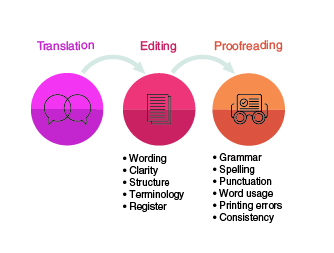Translation, editing, and proofreading (TEP) are the main stages of the translation process. These three consecutive steps often ensure the best translation quality. Still, many professionals argue that TEP are not necessary for proper project outcomes.
For example, some industry professionals say that translated text is acceptable so long as clients are satisfied. Another group considers translation quality is acceptable if the text is “good enough” for the people who will read it. Such editors correct the text only if it is necessary for reader satisfaction.
Whatever concept we accept, it is important to remember about the main steps of the translation process – translation, editing and proofreading (TEP). Revision or editing is the phase that follows translation. Editors check the target-language content against the original, and ensure that the message from the source text delivers the intended idea accurately. After this bilingual check, they make sure that the paragraphs read smoothly and are clear. Proofreaders work only with the target text, checking that the translation does not have any spelling, grammar, or punctuation errors.
TEP: translation editing
Readers want to be able to grasp the subject matter easily, without having to go over a sentence several times to get the point. Editors smooth the text and polish sentences. They establish a clear structure that ensures consistent information flow and focus.
To adjust vocabulary and sentences to fit readers’ needs, editors need to be able to imagine the readers clearly.

Is the text for professionals in the field or for laypeople? The latter will need any difficult concepts and terms to be explained. On the flip side, specialists will prefer content that includes the specific terminology and less explanation. Otherwise, they may doubt that the text is written for professionals.
What is the level of readers’ education? This is especially important in text that aims to convey crucial information to the public (e.g., public-health and bank-services documents).
Are the readers native speakers? Many foreigners will be unfamiliar with slang or metaphors based on local sports, like the idiom from cricket to get knocked for six.
Are the readers American? If so, then editors have to eliminate “Britishisms,” for example changing revise to review and flavour to flavor.
Is the text a newsletter for employees or a brochure for prospects? This may affect whether its style should be conversational or more formal.
What is the purpose of the text? For example, it might be to provide enjoyment to convey instructions, to help readers make a decision, or to inform them.
Where will the text appear (for example, on a mobile app, in a newspaper, on a sign-board, or in presentation slides)?
Answers to all these questions are essential in order to make reasonable corrections to translated texts.
TEP: translation proofreading
Proofreaders check grammar, syntax, spelling, punctuation, and consistency. These specialists also review typographical and layout features, such as style of headings and paragraphs.
Misspellings and typos might seem minor and unimportant, but they can make a negative impression on the readers, who may subconsciously lose confidence in the content of the work. Typos may even affect the meaning (compare confirmation and conformation).

Native speakers usually do not make idiomatic or syntactical mistakes. But if proofreaders are new to a field, they can have problems with specific phraseology. In his book, Brian Mossop gives an example of the meteorological term summer severe weather. An inexperienced proofreader may be tempted to change this to severe summer weather. But these are different concepts in the field of metereology: When a severe weather event occurs in summer, it is summer severe winter; when it occurs in winter, it is winter severe weather.
Correct punctuation is a vital component of a successful translation project. Punctuation rules differ between languages, so translators may inadvertently use commas, periods, or quotation marks incorrectly. Proofreaders have to pay special attention to small details, such as the different lengths of a dash and a hyphen.
Consistent terminology and style need special attention, especially if several translators are working on one project. Some organizations even prepare style and terminology guides. These documents give instructions on spelling (advertise or advertize), capitalization, hyphenation, numerals (2,000 units or 2 000 units), acronyms, quotations, and much more. They can also provide information on how to address the readers of the text—in the second or third person, and in the passive or active voice. For example, each of the phrases “sign the document,” “the document must be signed,” “the employee will sign the document,” and “let’s sign the document” would lend the text a different tone.
Translation tools
Editors and proofreaders can use technology for their work. Some tools are made to be used by the public, while others are developed for professionals. Simple Google search can help the translator and editor to know how words can be combined idiomatically. By entering the expression in a search box, we can get a large number of instances within seconds. Editors can also use glossaries or bilingual databases such as Linguee.
Professional translation tools—e.g., translation memory and translation quality-assurance software—can help translators, editors, and proofreaders. Translation QA tools can spot the inconsistent translation of terms, and untranslated passages. They can also find some proofreading errors, including checking paired punctuation marks (parentheses and quotation marks), the correct transcription of numbers, etc. Using these tools during the quality-control phase may support linguists to catch formatting errors that the human eye may miss. However, software is never a complete substitute for the skill of professional editors and proofreaders.
What is your experience with TEP? Do you prefer to follow this procedure or stick to the concept of “good enough” translation quality? What does “high-quality translation” mean for you? Do share your experience with us in the comments section below.


Edie as Translator
Good post, especially part of “TEP: translation proofreading”. Thanks
Natalia Guevara
There is something wrong with this sentence: “When a severe weather event occurs in summer, it is summer severe winter; when it occurs in winter, it is winter severe weather.”